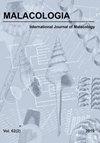Impact of Intertidal Distribution on the Physiological Performance of the Filter-Feeder Bivalve Perumytilus purpuratus (Bivalvia, Mytilidae) from Southern Chile
IF 1
4区 生物学
Q4 ZOOLOGY
引用次数: 0
Abstract
ABSTRACT Intertidal animals experience reduced feeding times and differentiated respiratory capacity associated with aerial exposure, the duration of which depends on their location within the intertidal zone. Perumytilus purpuratus is a sessile mussel that forms dense mats in the rocky mid-intertidal in southern Chile. For this species, we documented the impact of different times of aerial exposure (3 and 6 h) on rates of oxygen consumption and feeding, according to their vertical location (upper and lower limits) within the intertidal zone. Mean oxygen consumption rates in air for individuals located in the upper intertidal zone were 52% higher than those of individuals located at the lower limits of their intertidal distribution. Additionally, individuals from the lower intertidal region always presented higher rates of oxygen consumption and particle clearance rates (58% higher and 18% higher, respectively) during immersion compared to individuals collected from the upper limit of their intertidal distribution, regardless of the duration of previous aerial exposure. Although we found no significant habitat-related differences in the relationship between shell length and gill surface area, individuals sampled from the lower intertidal zone were 8% heavier in dry tissue weight than individuals with the same shell lengths collected from of the upper limit of their intertidal distribution. Our results suggest that the individuals of this species near the upper limits of their intertidal distribution can probably compensate (e.g., higher absorption rate) for the reduced time that they have available for clearance, which might help them to avoid a major energetic disadvantage.潮间带分布对智利南部滤食性双壳虫生理性能的影响
潮间带动物的摄食时间和呼吸能力与空气暴露有关,其持续时间取决于它们在潮间带内的位置。紫贻贝(Perumytilus purpuratus)是一种无底贻贝,在智利南部的潮间带中部的岩石中形成密集的席子。对于这一物种,我们记录了不同的空中暴露时间(3和6小时)对氧气消耗和摄食率的影响,根据它们在潮间带内的垂直位置(上限和下限)。潮间带上游个体的平均耗氧量比潮间带分布下限个体的平均耗氧量高52%。此外,与之前的空气暴露时间无关,来自潮间带下游地区的个体在浸泡期间的耗氧量和颗粒清除率始终高于来自潮间带分布上限的个体(分别高出58%和18%)。虽然壳长和鳃表面积之间的关系没有明显的生境相关性,但在潮间带下游取样的个体的干组织重比在潮间带分布上限取样的个体重8%。我们的研究结果表明,在潮间带分布的上限附近,该物种的个体可能会补偿(例如,更高的吸收率)减少的可用清除时间,这可能有助于它们避免主要的能量劣势。
本文章由计算机程序翻译,如有差异,请以英文原文为准。
求助全文
约1分钟内获得全文
求助全文
来源期刊

Malacologia
生物-动物学
CiteScore
2.00
自引率
0.00%
发文量
15
审稿时长
3 months
期刊介绍:
Malacologia publishes papers on all groups of the Mollusca. Malacologia specializes in publishing long papers and monographic treatments. Complete data are especially appreciated. Papers must be of interest to an international readership. Papers in systematics, ecology, population ecology, genetics, molecular genetics, evolution and phylogenetic treatments are especially welcomed. Also welcomed are letters to the editor involving papers published or issues of import to science of the day.
 求助内容:
求助内容: 应助结果提醒方式:
应助结果提醒方式:


